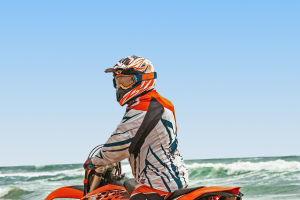Paragliding
Paragliding is the recreational and competitive adventure sport of flying paragliders: lightweight, free-flying, foot-launched glider aircraft with no rigid primary structure.
The pilot sits in a harness or lies supine in a cocoon-like 'pod' suspended below a fabric wing. Wing shape is maintained by the suspension lines, the pressure of air entering vents in the front of the wing, and the aerodynamic forces of the air flowing over the outside.
Despite not using an engine, paraglider flights can last many hours and cover many hundreds of kilometers, though flights of one to two hours and covering some tens of kilometers are more the norm. By skillful exploitation of sources of lift, the pilot may gain height, often climbing to altitudes of a few thousand meters.
The ideal launch training site for novices with standard wings has the following characteristics:
1.Measured steady wind strength: 1 m/s to 4 m/s (3.6-14 km/h: 1.9-7.7 knots/h: 2.2-8.9 mph)
2.The even, flat, surface should slope slightly downwards (2 or three degrees) from down-wind to up-wind (providing a small vertical lift component).
3.The site must be isolated from uninvolved visitors.
4.Free of obstructions that might create a trip or snag hazard.
5.Soft surface, such as grass or sand, to reduce damage to the handler and wing in case of falls.
6.Novices should wear a harness and helmet and be accompanied by an appropriate adult.
As pilots progress, they may challenge themselves by kiting over and around obstacles, in strong or turbulent wind, and on greater slopes.
Paragliding in suburban, built-up areas presents hazards where paragliding must be done from a safe distance. Power lines, roads, tall trees, schools, shopping centres and large car parks must be avoided. Some countries have restrictions in place which don’t allow you to paraglide within a certain distance of these hazards. If your country doesn’t have these restrictions, it’s still worthwhile to be cautious and paraglide from a safe distance.
Many areas of government owned land are no fly zones. These include military bases, police land, and the homes of distinguished government representatives. Paragliding over and landing in these areas is not allowed due to privacy reasons, and restrictions on public access.
You also can’t paraglide over or land on designated ‘no fly’ zones. These are usually located close to popular paragliding launch and landing zones. These are usually from home/landowners who seek privacy or have had negative experiences with pilots causing damage to their property. Take these into account when planning your flight and look for alternative close-by bombout areas in the event you need to land unexpectedly.
It’s important to take the approach that landowners who haven’t designated their property as a no-fly zone still may not be entirely happy about paragliders flying close over or landing on their property. Don’t fly so close that you compromise their privacy. If you do need to unexpectedly land on private property, quickly pack up your paraglider, ensure you have all your belongings and leave the property at the closest exit.
The learning of the basic physical skills is relatively easy; substantially easier than learning the basic skills of hang gliding. Paragliding is almost certainly the easiest form of flying to get started in. There are advanced skills required to fly safely at anything beyond the basic beginner level, and these skills are somewhat more challenging to learn. In addition, a pilot needs to learn at least some basics about weather, and the aerodynamic principles of flight.


